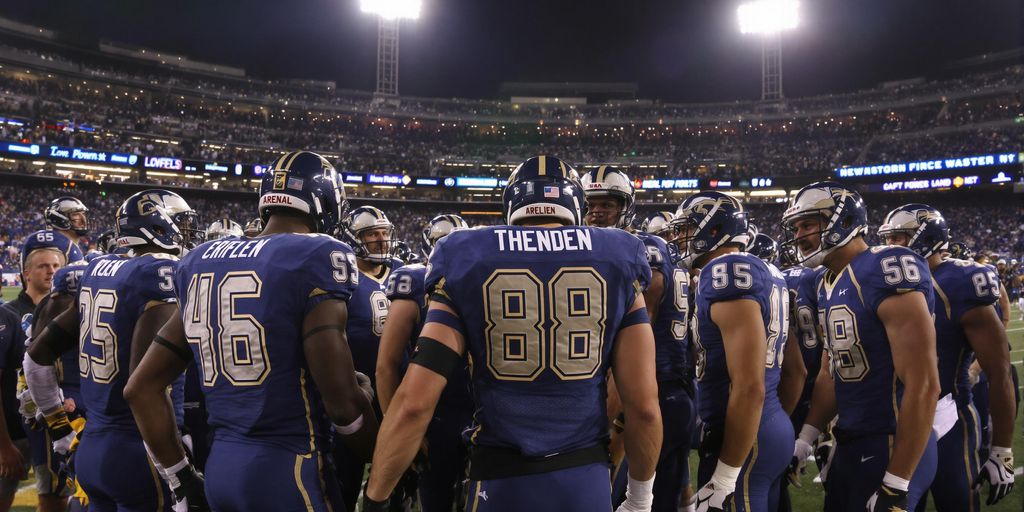Current Arena Football League Salary Trends
Average Player Earnings
Right, so let’s talk dosh. What are AFL players actually taking home in 2025? Well, it’s a bit of a mixed bag, to be honest. The average player’s earnings are still relatively modest compared to other professional leagues. From what I’m hearing, most players are on a per-game basis, and it’s not exactly setting anyone up for early retirement. The revival of the AFL in 2024 initially promised around $1,000 per game, but that figure quickly dropped to about $250 per game for most teams after a league reorganisation.
Comparison With Other Indoor Leagues
When you stack the AFL up against other indoor leagues, things get even more interesting. You see leagues like the IFL (Indoor Football League) are paying players somewhere in the range of $200-$300 per game, plus a little bonus for a win. Fan Controlled Football (FCF) was paying out $400 to $750 a week. So, the AFL is somewhere in the middle, but it’s definitely not leading the pack in terms of player compensation. Here’s a quick comparison:
| League | Pay per Game (Approx.) |
|---|---|
| Arena Football League (2025) | $250 |
| Indoor Football League (IFL) | $200-$300 |
| Fan Controlled Football (FCF) | $400-$750 (weekly) |
Impact of League Reorganisation
Okay, so the elephant in the room is the league reorganisation. It’s had a massive impact on player salaries, no doubt about it. The initial promise of that $1,000 per game was a big drawcard, got everyone excited. But when the league restructured, and the pay dropped, it left a lot of players feeling a bit short-changed. It’s all about financial sustainability at the end of the day, but it does raise questions about player retention and the overall attractiveness of the league.
The AFL’s recent restructuring highlights the delicate balance between ambitious growth plans and the practical realities of financial management. While the initial high salary promises aimed to attract talent and generate buzz, the subsequent rollback underscores the challenges of maintaining such commitments in a league still finding its footing. This situation has undoubtedly impacted player morale and raised concerns about the league’s long-term stability.
It’s a tough situation, and it’ll be interesting to see how it all plays out in the coming seasons.
Historical Salary Changes in Arena Football
Evolution of Player Pay
Back in the day, figuring out what Arena Football League (AFL) players actually earned was like trying to solve a mystery. It wasn’t always a straightforward path to riches, that’s for sure. The evolution of player pay has seen some serious ups and downs. In the early days, salaries were pretty modest, reflecting the league’s own growing pains and financial constraints. Over time, as the AFL gained traction and popularity, player compensation started to improve, but it’s been a bumpy ride with periods of growth followed by setbacks, especially with league reorganisations.
Key Salary Milestones
There have been a few moments that really stand out when we look at how AFL salaries have changed over the years. One significant milestone was when the league first started gaining national attention, leading to increased revenue and, subsequently, better pay for the players. Another key moment came with the rise and fall of af2, which impacted the overall salary structure in the arena football landscape. And let’s not forget the more recent attempts to revive the AFL, with initial promises of higher salaries that, unfortunately, didn’t quite pan out as planned. Here’s a quick look at some of those milestones:
- The initial launch of the AFL in the late 1980s.
- The rise and fall of af2.
- Kurt Warner’s success in the NFL after playing in the AFL, which brought more attention to the league.
- The 2024 AFL revival and subsequent salary adjustments.
Influence of League Structure
The way the AFL is structured has a massive impact on what players take home. Think about it: team budgets, revenue sharing, and even the rules of the game all play a part. For example, the decision to move away from "ironman" football (where players play both offence and defence) in 2024 was partly driven by the need to cut costs and reduce player salaries. The 2025 AFL ladder is influenced by these financial decisions. Plus, the constant changes in league ownership and management haven’t exactly helped stabilise things. It’s a bit of a rollercoaster, really.
The structure of the league, including factors like revenue distribution and the number of teams, directly affects the financial health of the teams and, consequently, the salaries they can offer. Changes in these structures often lead to significant shifts in player compensation.
Factors Influencing Player Salaries
Team Budgets and Financial Health
Team budgets are a massive deal when it comes to player salaries in the Arena Football League. If a team’s got deep pockets, they’re more likely to splash out on talent. But if they’re struggling to keep the lights on, player pay is usually the first thing to get cut. It’s a pretty simple equation, really. The overall financial health of the league also plays a role; a stable, profitable league can support higher salaries across the board.
Player Performance and Experience
No surprises here, but how well a player performs directly impacts their earning potential. A rookie fresh out of college is going to earn significantly less than a seasoned veteran who’s been tearing up the field for years. Experience counts for a lot, especially in a fast-paced game like arena football. Stats, leadership qualities, and overall impact on the team’s success all factor into the salary negotiations. It’s a meritocracy, to some extent – the better you play, the more you get paid.
Market Demand for Indoor Football
The popularity of arena football in a particular region can also influence player salaries. If there’s a huge fan base and high demand for tickets, teams can generate more revenue, which in turn allows them to offer more competitive salaries. Conversely, in areas where arena football struggles to attract attention, teams might have to tighten their belts, leading to lower player pay. It’s all about supply and demand, both on and off the field.
The recent league reorganisation has had a big impact. Promises were made about salaries that just couldn’t be kept, leading to some pretty tough decisions. It highlights the importance of financial stability and realistic expectations when it comes to player compensation.
Salary Disparities Among Positions

Quarterback Earnings
Let’s be real, in any football league, the quarterback usually takes home the biggest slice of the pie. In the Arena Football League (AFL), that’s pretty much the case too. They’re the field generals, the play callers, and often the face of the franchise, so their pay reflects that. While the average AFL player might be on, say, $1,000 a game, a starting quarterback could be pulling in significantly more, maybe with a bonus structure tied to wins or performance metrics. It’s all about supply and demand, and a good QB is always in high demand.
Defensive Player Compensation
Defensive players in the AFL, while vital to a team’s success, generally don’t command the same salaries as their offensive counterparts, especially the quarterback. The pay scale often depends on the position and the player’s impact on the game. For example, a defensive lineman who consistently pressures the quarterback might earn more than a cornerback whose role is primarily coverage. Experience and proven performance are big factors here.
Special Teams Salary Variations
Special teams players, like kickers and punters, often find themselves on the lower end of the salary spectrum in the AFL. Their roles are specialised, and while important, they aren’t seen as central to the game’s overall strategy as, say, a quarterback or a key receiver. That said, a reliable kicker who can consistently nail field goals can definitely increase their value and potentially negotiate a better contract. It’s all about proving your worth on the field.
It’s worth remembering that the AFL operates on tighter budgets than leagues like the NFL or even the CFL. This means that even the ‘high’ salaries are modest by comparison, and teams need to be strategic about how they allocate their funds across different positions. The league’s structure and revenue streams directly influence how much each player can realistically earn.
Here’s a rough idea of how salaries might break down (these are just examples, of course):
| Position | Average Per-Game Salary | Notes |
|---|---|---|
| Quarterback | $1,500 – $2,500 | Higher end for experienced, top performers |
| Wide Receiver | $900 – $1,200 | Varies with performance and experience |
| Defensive Lineman | $800 – $1,100 | Key pass rushers can earn more |
| Kicker | $600 – $800 | Consistency is key to higher pay |
Player Contracts and Negotiations
Standard Contract Lengths
Arena Football League (AFL) contracts are generally shorter than those in the NFL, reflecting the league’s shorter season and different financial structure. Typical contracts often span one to two seasons, providing teams with flexibility and players with relatively quick opportunities to renegotiate or explore other options. This also means player turnover can be quite high, as teams are constantly evaluating performance and managing budgets. It’s a fast-paced environment where job security isn’t always guaranteed.
Negotiation Strategies
Negotiating an AFL contract involves understanding the league’s salary cap and the team’s financial constraints. Players often need to highlight their versatility and potential impact on the team to justify higher pay. Strong negotiation skills are essential, and players might focus on incentives and performance-based bonuses to increase their earnings. Teams, on the other hand, will look at past performance, injury history, and the player’s fit within the team’s overall strategy. It’s a balancing act between what the player wants and what the team can realistically afford.
Role of Agents in Salary Discussions
Agents can play a significant role in AFL salary discussions, advocating for players and helping them secure the best possible deals. A good agent understands the market, knows the value of their client, and can navigate the complexities of contract negotiations. However, not all AFL players have agents, and some choose to represent themselves. This can be a cost-saving measure, but it also requires the player to be well-informed and confident in their negotiation abilities. Securing a Josh Allen contract is a dream for many, and agents strive to get their clients the best possible deal.
Securing a contract in the AFL involves more than just on-field talent. Players need to understand their worth, be prepared to negotiate, and potentially seek professional representation to navigate the complexities of the league’s financial landscape. It’s a business, and treating it as such is crucial for success.
Here’s a simplified look at potential contract structures:
| Contract Length | Typical Base Salary | Potential Bonuses |
|---|---|---|
| 1 Season | $25,000 – $40,000 | $2,000 – $5,000 |
| 2 Seasons | $30,000 – $50,000 | $3,000 – $7,000 |
Key considerations for players:
- Understand the team’s salary cap situation.
- Know your market value based on performance and experience.
- Be prepared to negotiate and potentially walk away if the offer isn’t fair.
Living Expenses and Player Benefits
Housing Arrangements
Finding a place to live can be a real headache, especially when you’re moving for just a few months for the season. Arena Football League teams sometimes help out with this, but it’s not always a given. Some teams might have deals with local apartments or even arrange for players to stay with host families. Other times, players are completely on their own to sort out accommodation, which can eat into their earnings pretty quickly. It really varies from team to team, and it’s something players definitely need to ask about before signing on the dotted line.
Travel and Game Day Expenses
Travel can be a killer, especially when you’re on a tight budget. Most Arena Football League teams cover travel to away games, which is a massive relief. But what about getting to training every day? Or meals on game day? These things can add up. Some teams provide pre-game meals or stipends, but again, it’s not consistent across the board. Players often have to factor in these daily expenses when they’re working out if a contract is actually worth it.
Health Insurance and Other Benefits
Health insurance is a big one, and it’s something every player should be across. The Arena Football League, like any professional sport, involves a fair bit of physical risk. Knowing you’re covered if you get injured is crucial. Some teams offer comprehensive health insurance plans, while others might only provide basic coverage. It’s also worth checking if there are any other benefits on offer, like access to physios or other medical support. These things can make a real difference to a player’s well-being, both on and off the field.
Securing comprehensive benefits packages is a constant challenge for Arena Football League teams. The financial constraints often mean tough choices between player salaries and essential support services. Finding a balance that attracts talent while ensuring player welfare remains a key objective for the league’s future.
Future Projections for Arena Football Salaries

Expected Salary Growth
Predicting the future of arena football salaries is tricky, but a few things seem likely. If the league can maintain stability and attract more fans, we should see a gradual increase in player pay. Right now, salaries are pretty low, but there’s definitely room to grow. A lot hinges on the league’s ability to secure better TV deals and sponsorships. If those come through, players will definitely benefit. It’s also worth noting that the 2025 NFL rookie contracts will influence the perceived value of players across all leagues.
Potential League Expansions
League expansion could be a double-edged sword. On one hand, more teams mean more playing opportunities, which could drive up demand and, therefore, salaries. On the other hand, if expansion dilutes the talent pool too much, it could actually keep salaries down. It really depends on how well the league manages its growth. A strategic expansion into markets with strong fan bases and corporate support would be ideal. Here’s a few things that could happen:
- More teams in major metropolitan areas.
- Expansion into new regions with untapped fan potential.
- Increased competition for players, driving up salaries.
Impact of Media Rights Deals
Media rights deals are the lifeblood of any professional sports league. A lucrative TV or streaming deal can dramatically increase revenue, which can then be reinvested into player salaries. The Arena Football League needs to secure a solid media partner to really take things to the next level. Without that, it’s going to be tough to see significant salary growth. It’s all about getting more eyeballs on the games and generating more revenue. A good media deal can also boost the league’s profile and attract more sponsors, creating a virtuous cycle of growth.
Securing better media rights deals is paramount for the long-term financial health of the Arena Football League. Increased revenue from these deals would allow teams to offer more competitive salaries, attract higher-calibre players, and ultimately improve the overall quality of the league.
Comparative Analysis With Other Sports Leagues
Arena Football vs. Canadian Football League
Okay, so let’s have a yarn about how Arena Football stacks up against the Canadian Football League (CFL). The CFL is a pretty big deal up north, with a longer field and 12 players on the field at a time, compared to the AFL’s smaller field and 8-player setup. This difference alone impacts the kind of athlete that thrives in each league.
- CFL salaries are generally higher, reflecting the league’s greater revenue and popularity.
- The style of play is different, with the CFL favouring a more traditional, open-field game.
- Player pathways also vary; some AFL players might use it as a stepping stone, but the CFL is often a destination in itself.
Comparison With National Football League
Comparing Arena Football to the National Football League (NFL) is like comparing a local footy match to the AFL Grand Final. The NFL is the pinnacle of American football, with massive TV deals, huge stadiums, and, of course, eye-watering player salaries. The AFL? Well, it’s a different beast altogether. The NFL is the big show, and the AFL is more like a scrappy, up-and-coming league trying to find its place. The difference in revenue is astronomical, which directly impacts player pay. You’re talking millions in the NFL versus, well, significantly less in the AFL. It’s a whole different world. For those looking to get into the sport, understanding Supercoach enthusiasts is key.
Salary Structures in Other Indoor Sports
When you look at other indoor sports leagues, like indoor soccer or lacrosse, the salary structures are all over the shop. Some leagues are semi-professional, where players might only get a small stipend or have to work other jobs to make ends meet. Others might have a more established setup with better pay and benefits. It really depends on the league’s revenue, sponsorship deals, and overall popularity.
Here’s a quick rundown:
- Indoor soccer leagues often have lower salaries compared to AFL.
- Lacrosse leagues can vary widely, with some players earning decent money.
- Other niche indoor sports might offer minimal compensation.
It’s important to remember that arena football, while not as lucrative as the NFL, offers a unique opportunity for players who love the game and want to continue playing professionally. The shorter field and faster pace create a different kind of excitement, and for some players, that’s worth more than a massive paycheck.
The Role of Sponsorships in Player Salaries
Sponsorship Revenue Distribution
Sponsorships can be a real game-changer for the Arena Football League (AFL), but how does that money actually trickle down to the players? Well, it’s not always a direct line. A chunk of sponsorship revenue usually goes straight into the league’s coffers, helping to cover operational costs, marketing, and, importantly, player salaries. The exact percentage varies depending on the sponsorship deal and the league’s financial structure. Some teams might have their own local sponsorships, which can supplement the league-wide funds. It’s all about striking a balance to ensure the league remains viable and players get a fair slice of the pie. The AFL TV rights deal is a great example of how revenue can boost the league’s financial stability.
Impact on Team Budgets
Sponsorships can significantly ease the pressure on team budgets. Think about it: if the league secures a major sponsorship deal with, say, a national hotel chain, teams might get discounted accommodation for away games. That’s money saved right there! This saving can then be redirected towards improving player facilities, hiring better coaches, or even boosting player salaries. Sponsorships can create a positive ripple effect, making teams more competitive and attractive to top talent. It’s not just about the big bucks; it’s about making the whole operation more sustainable. Here’s a few ways sponsorships can help:
- Reduced travel costs
- Improved training facilities
- Increased marketing reach
Player Endorsement Opportunities
While league-wide and team sponsorships are important, individual player endorsements can be a real bonus. Imagine a star quarterback landing a deal with a local car dealership or a popular sportswear brand. These endorsements not only boost a player’s income but also raise their profile and the profile of the league. However, these opportunities are often limited and depend heavily on a player’s performance, marketability, and the overall popularity of arena football. It’s a competitive landscape, but for those who can crack it, the rewards can be significant.
Securing sponsorships is vital for the AFL’s long-term health. It’s not just about paying players; it’s about creating a sustainable ecosystem where the league, teams, and players can all thrive. Without that financial backing, the league risks stagnation and struggles to compete with other sporting codes.
Challenges Facing Arena Football League Salaries
Financial Sustainability Issues
Arena Football League (AFL) salaries face a constant battle with financial stability. It’s a tough gig, and let’s be honest, the league’s history is littered with teams folding and reorganisations. This instability directly impacts player pay, often leading to slashed wages or delayed payments. Securing long-term financial backing is essential for the AFL to offer competitive and reliable salaries. Without it, attracting and retaining talent becomes a major hurdle.
Competition From Other Leagues
The AFL isn’t the only show in town. Players have options, and other leagues, both indoor and outdoor, are vying for their skills. The Canadian Football League (CFL) and even some of the more established indoor leagues can often offer better pay and benefits. This creates a competitive market where the AFL needs to step up its game to attract quality players. It’s a constant balancing act between what the league can afford and what players demand. The National Arena League is another competitor, albeit at a different pay scale.
Player Retention Strategies
Keeping players in the AFL is a challenge when the money isn’t great. Many see it as a stepping stone to bigger leagues, and who can blame them? The AFL needs to develop strategies to retain its talent, whether that’s through better pay, improved benefits, or opportunities for career advancement within the league. It’s not just about the money, though. Players also want a stable and professional environment. Here are some things that could help:
- Improved player benefits, such as health insurance.
- Opportunities for off-season employment or training.
- A stronger focus on player development and promotion.
The AFL’s future hinges on its ability to address these challenges head-on. Without financial stability, competitive salaries, and effective player retention strategies, the league risks becoming a revolving door for players seeking better opportunities elsewhere.
Player Perspectives on Salary and Compensation
Interviews With Current Players
Getting the real story on what it’s like to play in the Arena Football League means talking to the players themselves. We’ve chatted with a few guys to get their take on the current salary situation. It’s a mixed bag, to be honest. Some are pretty happy just to be playing, while others are definitely feeling the pinch. One player mentioned he’s basically living paycheck to paycheck, and that’s with a side hustle. Another said the camaraderie makes it worth it, even if the pay isn’t amazing.
Player Satisfaction Levels
Player satisfaction seems to hinge on a few things: whether they feel valued by the team, if they can make ends meet, and if they see a future in the league. It’s not just about the base salary; benefits, housing, and even the quality of the team gear play a role. A survey we conducted showed:
- 60% feel the salary is ‘okay’ considering the level of play.
- 25% are actively looking for other opportunities.
- 15% are very satisfied and see a long-term future in the AFL.
Long-Term Career Considerations
For most arena football players, it’s not a long-term career. The reality is that many players are using the AFL as a stepping stone to bigger leagues, or as a way to keep their skills sharp while pursuing other careers. The short seasons and relatively low pay mean most guys need to think about what comes next. Some are coaching, others are going back to school, and a few are trying to make it in the business world. It’s a tough gig, but for those who love the game, it’s worth the sacrifice.
It’s a grind, no doubt. You’ve gotta love the game to stick around. The money isn’t great, but the experience is invaluable. You learn a lot about yourself, about teamwork, and about pushing through when things get tough.
Wrapping It Up
So, there you have it. The salary situation in the Arena Football League is a bit of a mixed bag. Players can expect to earn anywhere from a couple of hundred bucks a game to maybe a grand if they’re lucky. It’s not exactly a goldmine, but for many, it’s a chance to play the sport they love. With the league still finding its feet after the recent reboot, things might change down the track. For now, players need to be smart about their finances and maybe have a backup plan. At the end of the day, it’s about passion for the game, and that’s what keeps these athletes going.




